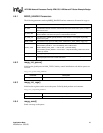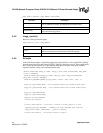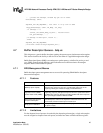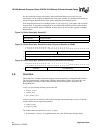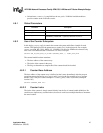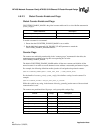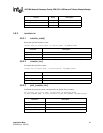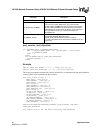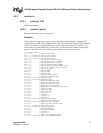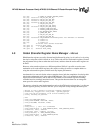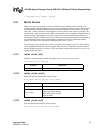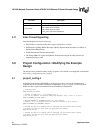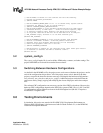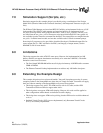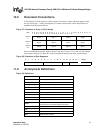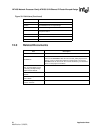
IXP1200 Network Processor Family ATM OC-3/12/Ethernet IP Router Example Design
54 Application Note
Modified on: 3/20/02,
4.11 Inter-Thread Signalling
Inter-thread signals are used in four ways:
• Initialization, as detailed in the “Microengine Initialization” section.
• Notification to a BDQ (Buffer Descriptor Queue) dequeue thread that data is available, as
detailed in the BDQ section.
• Within the Ethernet Transmit microengine.
• The StrongARM core signals the Ethernet Transmit microengine to notify it that it has
enqueued packets to send.
5.0 Project Configuration / Modifying the Example
Design
The design can be assembled with a variety of options, all of which are configurable in the header
files: project_config.h and system_config.h.
5.1 project_config.h
As detailed in the project’s README.txt, shared project source code can be simultaneously
complied and run in a number of different configurations. project_config.h is a small top-level
header file that is copied and modified into those different configurations.
// ATM Wire Rate
#define ATM_OC3_PORTS
// Number of ATM Ports -- OC3 defaults to 4.
// To run on IXD4521 "Rainsford" WAN Card Daughter Card, limit to 2 ports.
#define NUMBER_OF_ATM_PORTS 2
// Define NUMBER_OF_ETHERNET_PORTS to 4 for IXP1200.
// Default is 8, as supported by the IXP1240 version of this project.
#define NUMBER_OF_ETHERNET_PORTS 4
// Define SW_CRC_RX to enable CRC-32 checking via microcode table lookup.
// Project build must also load the appropriate threads.
#define SW_CRC_RX
// Define SW_CRC_TX to enable CRC-32 checking via microcode table lookup.
// Project build must also load the appropriate threads.
#define SW_CRC_TX
Parameter Description
out_abs_reg Absolute register containing the semaphores.
in_bit_number
bit number of the semaphore.
0 bits: critical section available.
1 bits: critical section occupied.
mutex_vector_exit clears specified bit.



